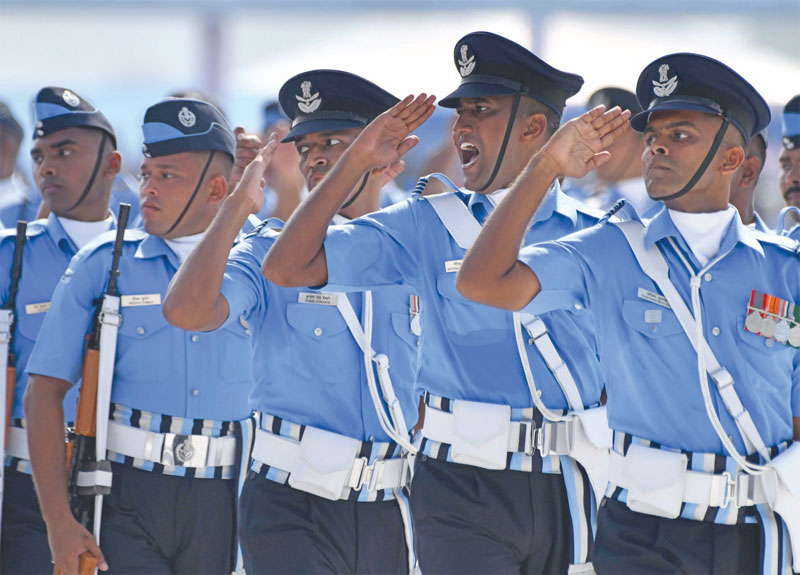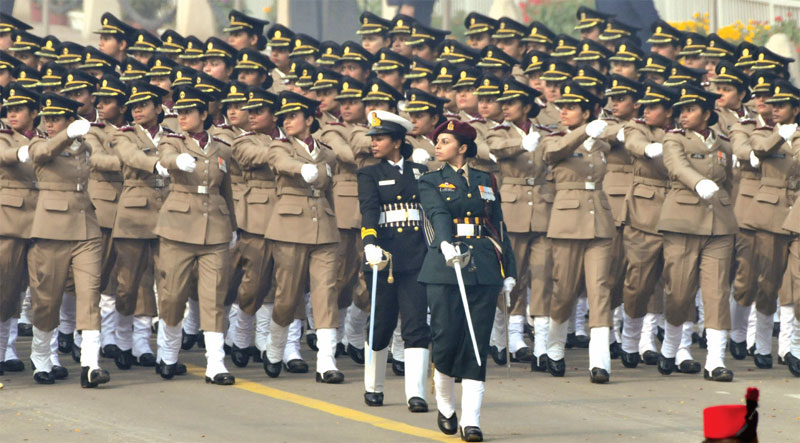The Changing Guard
 Cdr Shrikumar Sangiah (retd)
Cdr Shrikumar Sangiah (retd)
In India, and indeed in much of the world, a soldier evokes in people a curious mix of respect, admiration, and misunderstanding. The stereotypical image, in people’s minds, of a soldier is that of a disciplined and authoritarian figure -- stoic, fearless, dedicated to the service of the nation, and living by a rigid set of rules and standards. Portrayed as heroes, soldiers are seen as embodying strength -- physical, mental, and moral.
This stereotype is shaped by a mix of cultural narratives, media portrayals, and the military’s history of selfless service. For instance, literary works such as Rudyard Kipling's The Young British Soldier, excerpted here, serve to reinforce the soldier stereotype (besides other colonial stereotypes):
When you’re wounded and left on Afghanistan’s plains,
And the women come out to cut up what remains,
Jest roll to your rifle and blow out your brains,
An’ go to your Gawd like a soldier.
The soldiers, when faced with the most fearful odds, are portrayed as choosing death over dishonour -- embodying the ideals of bravery, fortitude, and unyielding mental and moral strength.
Military Leadership
The military has traditionally enforced adherence to a prescribed ‘model’ of conduct through a hierarchical organisational structure and the threat of punishment. Although this traditional approach to leadership has served the armed forces well in the past, the modern, technology-driven military requires a shift toward a leadership philosophy that leverages intrinsic motivation, personal responsibility, and voluntary adherence to the expected standards rather than one based on an authoritarian, hierarchical organisational structure.
People, everywhere, instinctively oppose authoritarianism and like to be told the whys and wherefores of the instructions that they are expected to act upon.

The hierarchical and authoritarian nature of military organisation arises from the need to exercise effective command over the troops during war. Supporters of authoritarianism in the military, proffer the argument that the need for effective military command precludes any space for tolerance or a more collegial style of management. Work procedures in the military are standardised and career advancement is strongly linked to compliance with the standardised procedures.
The increased reliance on technical skills for success in wars necessitates the softening of the authoritarian approach and a shift towards reliance on teamwork and consultative decision making. This will require military commanders to learn new ways of managing soldiers and maintaining their morale.
While the military has stringent physical and psychological entry requirements, many service members, especially those in specialised roles, may not need to fit the stereotype of the ‘ideal’ soldier. Modern militaries require individuals with specialised skills -- not always aligned with traditional expectations. For instance, the rise of cyber warfare and drone operations demand highly skilled technical personnel. In these roles, intellectual and technical capabilities count for more compared to physical attributes. The induction of technology has led to the rise of a range of newer attributes, related to specialised technical expertise, that differ vastly from the stereotypical military attributes.
The transition from an authoritarian model to one that encourages voluntary compliance with military ideals presents both challenges and opportunities. Creating a culture in which the personnel are intrinsically motivated to uphold the core values of the military, requires a more enlightened approach to leadership -- one that encourages self-discipline and a sense of purpose.
A key component of intrinsic motivation is the ability to see the greater purpose behind one’s actions. The most effective means of inspiring intrinsic motivation is for leaders to model the behaviours they expect from their subordinates. Soldiers are more likely to strive for professional competence and begin valuing discipline, ethical conduct, personal integrity, and physical fitness -- when they see their officers and superiors consistently demonstrating these qualities. The ‘leadership by example’ philosophy creates a culture where soldiers experience a sense of pride and responsibility toward the military’s ideals, rather than simply obeying instructions out of fear.
Further, intrinsic motivation thrives in an environment where individuals are recognised for their contributions and are also, simultaneously, held accountable for their actions. Rewarding achievement -- whether through formal recognition or informal praise -- will encourage soldiers to internalise the values of excellence and discipline. However, this recognition should be tied to actions that align with the military’s larger purpose and ethical code, rather than mere performance-based metrics. At the same time, by being held accountable, soldiers need to internalise that their actions have consequences, not in a punitive sense, but as part of a system that values responsibility.
The Changing Face of Military Leadership
In the early years of the 18th and 19th centuries, the professional soldiers in the west traced their social origins to the feudal nobility of Europe and the southern ‘plantocracy’ of the US. Men were born into the officer class and merit had little or no role in helping them gain entry. The feudal basis of the officer cadre led to the military leadership’s heavy reliance on tradition, custom, and social position in exercising its authority. It also tended to be conservative and given to pomp and ceremony.
During the periods before and immediately after independence in 1947, the Indian military too mirrored this trend with several members of the Indian ‘royalty’ and the local elite serving as officers, before the numbers of the professional soldier began to dominate the officer cadre.
With the nobility monopolising officership in the military, it was only natural for them to strive to protect their social position and their customs and traditions. However, with the steady infusion of technology in the military -- and as a consequence the greater demand for technical talent -- the social base of the military widened and the relative numbers of the nobility gradually began to decline. The infusion of technology also shifted the spotlight from the military leader with the ‘martial spirit’ and personal valour to the military ‘manager’ with the skills to plan and oversee the most effective use of available technology and personnel.
The officer cadre in the military has been experiencing a gradual but steady transformation. The officer cadre, now drawn from a broader social base, is more representative of wider society. While the broadening of the base has been necessitated by the growth in the size of the military and the increased demand for technically trained personnel, it also signals a move away from the monopoly of the elite over the officer corps.
The acts of preparing for and waging war require dealing with uncertainties. Organisational conservatism is the instinctive reaction to uncertainty. The increased adoption of technology and the rise of the military manager has helped weaken organisational conservatism and has spurred the professionalisation of the military. Also, even as the military has become more technology dependent and the role of the military leader as ‘manager’ has gained salience, the role of the heroic leader has not diminished.
The Colonial Legacy
A large proportion of the processes and traditions that keep the Indian military functioning carry a strong colonial imprint. The processes, traditions, ceremonies, rituals, and much of the ostentation and pomp are a legacy handed down from the Raj-era military.
Many colonial-era practices -- anachronisms in the military of any modern, sovereign state -- have been scrapped in the home militaries of the original colonising states. However, the Indian military has made little serious attempt to jettison these outdated practices and continues to retain much of its Raj-era character -- except for some superficial and cosmetic changes to a few processes and uniforms.
This should come as no surprise since many of our military academies and training establishments were set up in pre-independence India and are run based on training manuals designed to turn out brown ‘sahibs' for the ‘Royal’ Indian military. The training philosophy has undergone little, if any, revision to reflect the military’s changed circumstances. Even the training academies established in the initial decades after 1947 were largely modelled on British military academies. The academies of more recent origin have also borrowed significant portions of their training philosophies from the American, western European, and Russian militaries.
The fact that the military, that is meant to fight wars, is concerned at all with protocol, ceremony and etiquette is a paradox. The only plausible explanation for the military’s obsession with ceremony and protocol is that they serve to embed the feeling in the soldiers of somehow being ‘special’.
The Motivations for a Military Career
In 1895, Alfred Thayer Mahan writing about a career in the navy, but what is also true more generally of the military, said, ‘In no event will there be money in it; but there may always be honour and quietness of mind and worthy occupation -- which are better guarantees of happiness.’
The profession of arms is more than a vocation. Very often, the demands on a soldier exceed his official duties. Military service comes with an ever-present overhang of mortal danger. For some, opting for a career in the military is a safe and rewarding career choice and not very different from the other available options. Those who view the military as just another job opt to serve based on an evaluation of what a career in the military offers rather than any motivation arising from a greater calling.
For a few, the choice of a career in the military is a deliberate decision holding the promise of some intangible, but greater gratification that they seek. For these few the military is a ‘calling’ and comes with a sense of ‘mission’ and ‘purpose.’ To them choosing a career in the military represents a conscious rejection of the corporate world and the embrace of an ‘honourable’ calling. For these professional soldiers, the ‘glory’ of military life and the ideal of serving the country holds sway over the blandishments of the business world.
Some others are motivated to choose a career in the military following a family tradition, others by the promise of a reasonable level of comfort during peacetime, and others still by an irrational boyhood ambition, an adolescent fantasy, or the promise of adventure. The numbers of those that see the military as a calling is far lesser than those following a family or social tradition or for whom the military is just another job.
Positive commitment to a military career has seen a marked decline in recent times with only a few children of military personnel choosing to follow in their parents’ footsteps. This could be because of a weakening of the system of ‘schooling’ in the military’s ethos.
The system of military schooling works through military academies, the academies of higher military training, and the daily routine of military life. Whatever be the initial motive for joining the military -- a sense of mission, or more prosaic, careerist reasons -- a life in the military and its constant preoccupation with preparing for combat engenders in the soldiers a feeling of superiority and a self-conception of uniqueness. This sense of superiority and uniqueness, at least partly, explains why the military which offers comparatively lower monetary rewards, is still able to attract young men and women to military service.

Military Training
Basic training at a service academy is the foundational and most crucial experience of a professional soldier. Basic training is designed to leave a deep and lasting impression and prepare the soldier for a life in the military by imbuing in him/her the standards of behaviour expected in the military. The academy, together with equipping the soldier with the skills required for soldiering, also prepares soldiers for the particular nature of life and work in the military.
Basic training brings about like-mindedness and a sense of fraternity, elevates physical fitness in preparation for the rigours of military life, and imparts training on other, relatively, higher-order and abstract concepts such as military and professional honour, duty, personal integrity, responsibility, leadership, gentlemanly conduct, etc.
Training at the academy is also intended to weaken any social and regional identities that the soldiers might come with. The training is designed to help them develop a broader national identity and begin self-identifying themselves as members of a professional fraternity. The professionalisation of the military and the increased representation in the officer cadre, of all strata of society, has led to a greater onus being placed on military academies in equipping the trainees with the requisite knowledge of military traditions, military etiquette, professional skills, etc. At the academies, strict discipline is used to engineer a quick transition from civilian to military life. Even some degree of hazing is employed (although never admitted) to ‘toughen’ the recruits and seed in them the ability to handle physical and mental stress.
During training, the physical environment of the academy also produces a positive impression on the trainees. The trainees undergo training in the same classrooms, walk the same corridors, and play on the playgrounds once used by great admirals and generals. As with the campuses of great universities, the physical environment of the academy imbues trainees with a sense of its glory, history, and the accomplishments of its alumni -- inspiring them to strive to live up to the academy’s high standards.
A study of the history of the achievements of the armed forces is also an essential tool in imbuing trainees with a sense of military honour. The teaching of military history in the academies should not be limited to the faithful recounting of all past events; it instead should be a deliberate and idealised interpretation of past events -- designed to inspire trainee soldiers.
If the concerns expressed by a serving Commodore in a private conversation, during a recent social gathering, are an indication of a general trend across the military, it would appear that the level of positive commitment among officers in the military is on the decline. A significant number of officers are opting to give up their commissions on completion of the mandatory minimum service period. To make up for the resultant shortfall in personnel numbers the military has, expectedly, adopted a more aggressive outreach and recruitment strategy. For the personnel coming in, in response to aggressive outreach strategies, the service academies will need to provide more intensive schooling in the military ethos in order to engender in them a stronger positive commitment to their service.
Training the modern soldier should also include greater emphasis on general education. Striking a balance between general education and soldierly skills and bringing about a synthesis between the two is what West Point alludes to as its conception of the soldier as a ‘whole man’.
The ‘whole man’ conception of military training is a recognition of the changed nature of the world, society, the military, and modern wars. The current focus on technical and engineering training in India’s service academies is aimed at equipping the academies’ graduates with the skills needed to devise scientific solutions to military problems. This focus, however, needs to be augmented with additional courses in man management, group psychology, military economics, international relations, and deep analyses of important past and current geo-political events.
The Bottom Line
It is clear that the archetype of the soldier must evolve beyond the stoic, disciplined figure of our collective imagination. The modern soldier will be characterised not only by personal valour and physical prowess but by intellectual agility, ethical clarity, and a strong sense of purpose.
The Indian military, with its mix of colonial and modern influences, must now face up to the imperative of redefining soldiering. The redefinition is not merely about adapting to technological advancements or responding to the demands of modern warfare; it is about igniting the intrinsic motivation that drives individuals to serve.
Leadership within the military must evolve to foster an environment where soldiers are not just followers of orders but are inspired by a vision that connects to the nation’s broader narrative. The challenge for India’s military institutions is to develop their own version of the ‘whole man’ concept -- tailored to India’s unique requirements and circumstances -- aimed at fostering a leadership ethos that embodies the values it seeks to instil in the soldiers and a culture where soldiers are motivated by a sense of honour and duty rather than by fear.
Subscribe To Force
Fuel Fearless Journalism with Your Yearly Subscription
SUBSCRIBE NOW
We don’t tell you how to do your job…
But we put the environment in which you do your job in perspective, so that when you step out you do so with the complete picture.








